 W
WAegyptosaurus meaning 'Egypt’s lizard', for the country in which it was discovered is a genus of sauropod dinosaur believed to have lived in what is now Africa, around 95 million years ago, during the Late Cretaceous Period. Like most sauropods, it had a long neck and a small skull. The animal's long tail probably acted as a counterweight to its body mass. Aegyptosaurus was a close relative of Argentinosaurus, a much larger dinosaur found in South America.
 W
WBetasuchus is a genus of theropod dinosaur which lived during the Late Cretaceous Period. Betasuchus is, besides Orthomerus, the only dinosaur genus named from remains found in the Netherlands and the only non-avian theropod found in the Maastrichtian Beds.
 W
WThe Caytoniales are an extinct order of seed plants known from fossils collected throughout the Mesozoic Era, specifically in the late Triassic to Maastrichtian period, around 250 to 70 million years ago. They are regarded as seed ferns because they are seed-bearing plants with fern-like leaves. Although at one time considered angiosperms because of their berry-like cupules, that hypothesis was later disproven. Nevertheless, some authorities consider them likely ancestors of angiosperms, whereas others consider angiosperms more likely derived from Glossopteridales. The origin of angiosperms remains an intriguing puzzle.
 W
WCheloniellon is a monotypic genus of cheloniellid arthropod, known only by one species, Cheloniellon calmani, discovered from the Lower Devonian Hunsrück Slate of Germany.
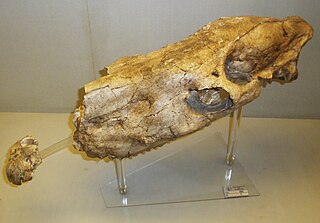 W
WEurygnathohippus is an extinct genus of hipparionine horse. The majority of known fossils of members of this genus were discovered in Africa, where members of this genus lived during the late Miocene to Pleistocene interval. Fossils of Eurygnathohippus were also reported from the late Pliocene sediments of the Potwar Plateau in Pakistan and the Siwalik Hills in northwest India.
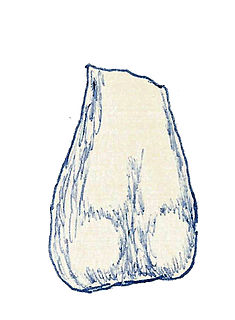 W
WFulgurotherium is the name given to a genus of ornithischian dinosaur from the Late Cretaceous (Cenomanian) Griman Creek Formation. It lived in what is now Australia.
 W
WGavialis browni is an extinct species of the crocodylian genus Gavialis and a close relative of the living gharial Gavialis gangeticus.
 W
WGobiatherium was one of the last Uintatheres, from the Mid Eocene of Mongolia. Unlike its North American cousins, Uintatherium or Eobasileus, Gobiatherium lacked knob-like horns, or even fang-like tusks. Instead, it had enlarged cheekbones and an almost spherical snout.
 W
WHypercoryphodon is an extinct genus of rhinoceros-sized pantodont native to Late Eocene Mongolia, and was very similar to its ancestor, Coryphodon. Described from a skull, Hypercoryphodon is a quadrupedal hippopotamus-like herbivore that may have been able to adapt its feeding to suit different situations. It is thought to have possibly lived in wetland to forest ecosystems that it might have shared with other herbivores such as dinoceratans like Gobiatherium.
 W
WIchthyostega is an early genus of tetrapodomorphs that lived at the end of the Late Devonian Period. It was one of the first four-limbed vertebrates in the fossil record. Ichthyostega possessed lungs and limbs that helped it navigate through shallow water in swamps. Although Ichthyostega is often labelled a "tetrapod" due to the possession of limbs and fingers, it was more basal ("primitive") than true crown-tetrapods, and could more accurately be referred to as a stegocephalian or stem tetrapod. Likewise, while undoubtedly of amphibian build and habit, it is not considered a true member of the group in the narrow sense, as the first modern amphibians appeared in the Triassic Period. Until finds of other early stegocephalians and closely related fishes in the late 20th century, Ichthyostega stood alone as a transitional fossil between fish and tetrapods, combining fish- and tetrapod-like features. Newer research has shown that it had an unusual anatomy, functioning more akin to a seal than a salamander, as previously assumed.
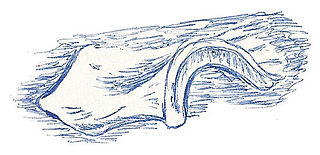 W
WIliosuchus is a genus of theropod dinosaur known from Bathonian–age rocks of England. It was perhaps 2 metres (6.6 ft) long.
 W
WKolpochoerus is an extinct genus of the pig family Suidae related to the modern-day genera Hylochoerus and Potamochoerus. It is believed that most of them inhabited African forests, as opposed to the bushpig and red river hog that inhabit open brush and savannas. There are currently eight recognized species.
 W
WMagnosaurus was a genus of basal tetanuran theropod dinosaur from the Middle Jurassic of England. It is based on fragmentary remains and has often been confused with or included in Megalosaurus.
 W
WMagyarosaurus is a genus of dwarf sauropod dinosaur from late Cretaceous Period in Romania. It is one of the smallest-known adult sauropods, measuring only six meters in length. The type and only certain species is Magyarosaurus dacus. It has been found to be a close relative of Rapetosaurus in the family Saltasauridae in the sauropod clade Titanosauria in a 2005 study.
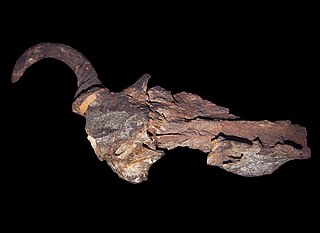 W
WMegalotragus was a genus of very large extinct African alcelaphines that occurred from the Pliocene to early Holocene. It resembled modern hartebeests, but differed in larger body size, it includes the largest bovids in the tribe Alcelaphini, reaching a shoulder height of 1.4 m (4.6 ft). The genus consists of three species of which Megalotragus priscus survived until the early Holocene 7.500 C14yBP.
 W
WPlateosauravus is a basal plateosaurian of uncertain affinities from the Late Triassic Elliot Formation of South Africa.
 W
WPlatyceramus was a genus of Cretaceous bivalve molluscs belonging to the extinct inoceramid lineage. It is sometimes classified as a subgenus of Inoceramus.
 W
WRapator is a genus of theropod dinosaur from the Griman Creek Formation of New South Wales, Australia, dating to the Albian-Cenomanian ages of the Cretaceous period, 105-96 million years ago. It contains only the type species, Rapator ornitholestoides, which was originally named by Friedrich von Huene in 1932.
 W
WSauropodomorpha is an extinct clade of long-necked, herbivorous, saurischian dinosaurs that includes the sauropods and their ancestral relatives. Sauropods generally grew to very large sizes, had long necks and tails, were quadrupedal, and became the largest animals to ever walk the Earth. The "prosauropods", which preceded the sauropods, were smaller and were often able to walk on two legs. The sauropodomorphs were the dominant terrestrial herbivores throughout much of the Mesozoic Era, from their origins in the mid-Triassic until their decline and extinction at the end of the Cretaceous.
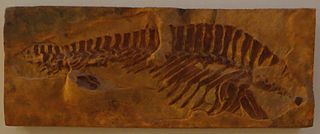 W
WSclerothorax is an extinct genus of temnospondyl amphibian from the Early Triassic of Germany. It is distinguished from other temnospondyls by its short and very wide skull and the elongated neural spines that form a ridge along its back. Sclerothorax is a basal member of Capitosauria, a large clade of temnospondyls that lived throughout the Triassic.
 W
WStenaulorhynchus is an extinct genus of hyperodapedontid rhynchosaur known from the Middle Triassic deposits of Tanganyika Territory, Tanzania. It was found in the Lifua Member of the Manda Formation in the Karoo Supergroup. It was named and first described by Sidney Henry Haughton in 1932. The type species is Stenaulorhynchus stockleyi, a beaked herbivore measuring 1–6 meters in length.
 W
WStenonychosaurus is a genus of troodontid dinosaur from the Late Cretaceous Dinosaur Park Formation of Alberta, Canada, as well as possibly the Two Medicine Formation. The type and only species, S. inequalis, was named by Charles Mortram Sternberg in 1932, based on a foot, fragments of a hand, and some caudal vertebrae from the Late Cretaceous of Alberta. S. inequalis was reassigned in 1987 by Phil Currie to the genus Troodon, which was reverted by the recognition of Stenonychosaurus as a separate genus from the possibly dubious Troodon in 2017 by Evans et al. and also later in the same year by Van der Reest and Currie.
 W
WSynthetoceras tricornatus is a large, extinct protoceratid, endemic to North America during the Late Miocene, 10.3—5.3 Ma, existing for approximately 5 million years . Fossils have been recovered from Nebraska and Texas.
 W
WWalgettosuchus is a dubious or maybe even invalid genus of extinct tetanuran theropod dinosaur, possibly belonging to the Ornithomimosauria due to the shape of the preserved caudal vertebra, that lived in Australia during the Late Cretaceous (Cenomanian). It is only known from a single caudal vertebra.